| Article ID | Journal | Published Year | Pages | File Type |
|---|---|---|---|---|
| 6576951 | Urban Climate | 2018 | 28 Pages |
Abstract
This study explored how heat island intensification affects precipitation in the Tokyo metropolitan area. Numerical experiments were made for the month of August from 2006 to 2013 using the Non-Hydrostatic Model (NHM) with a horizontal grid interval of 2 km and the Square Prism Urban Canopy (SPUC) scheme. We performed the experiments with two different specifications for the Tokyo area: the current highly urbanized surface conditions (CRNT experiment) and less urbanized conditions (MDUB experiment). The simulation results suggest that the mean monthly precipitation in the central Tokyo area was approximately 10% larger in the CRNT experiment than in the MDUB experiment, associated with a mean temperature rise of as much as 1 °C. We also examined the modification of daily precipitation characteristics in the two experiments. The CRNT experiment generally yielded larger amounts of area-maximum precipitation in the urban domain; however, differences between the experiments in daily precipitation varied among cases. Composite analysis was performed to investigate the processes associated with the differences in simulated precipitation. We found that in afternoon rainfall cases without preceding precipitation, a thermally induced change in circulation, particularly enhanced ascending motion, played an important role in the precipitation increase in the CRNT experiment.
Related Topics
Physical Sciences and Engineering
Earth and Planetary Sciences
Earth and Planetary Sciences (General)
Authors
Naoko Seino, Toshinori Aoyagi, Hiroshige Tsuguti,
